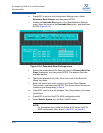
8–Configuring FCoE in a Linux Environment
Boot-from-SAN
8-32 FE0254601-00 A
Storage Array Requirements
Some storage arrays cannot support boot-from-SAN for specific environments.
Consult the storage array documentation to confirm that the array and the
firmware support boot-from-SAN. Consider the storage array and any limitations
regarding boot-from-SAN.
Create and present an appropriately-sized LUN to the QLogic 8100 Series
Adapter port. Ensure that:
The adapter port has exclusive access to this LUN.
The LUN host type matches the operating system that is to be installed on
this LUN.
Each server has its own dedicated boot LUN. Two servers cannot share the
same boot LUN.
Boot-from-SAN Configuration Topologies
One of the benefits of SAN adoption, and in turn, Boot-from-SAN, is high
availability, which is not easily achieved in a local boot scenario. Before proceeding
to the detailed instructions about configuring boot-from-SAN, determine the level of
fault tolerance and high availability required for boot-from-SAN installations. The
following sections describe two boot-from-SAN topologies: single-path
configuration (least fault tolerant) and multipath configuration (most fault tolerant).
Single-Path Topology
A single-path topology is the simplest configuration for boot-from-SAN for QLogic
8100 Series Adapters. The single-path configuration consists of a single adapter
port connected to a converged networking switch (FCoE switch), which is then
connected to the storage controller (SP) of a storage array. A single-path
configuration does not use redundant components, and therefore, is not
recommended for mission-critical servers.
However, single-path topology does offer some degree of fault tolerance, because
the QLogic 8100 Series Adapter can configure alternate boot LUNs. As shown in
Figure 8-12, if the primary boot device (LUN1) fails, or if it is not available at boot
time, the QLogic adapter automatically tries to boot from the alternate boot device
(LUN2). Up to four alternate boot devices can be configured, which provides
failover protection by redirecting the boot device without user intervention.


















